+Search query
-Structure paper
| Title | Structure of a dimeric photosystem II complex from a cyanobacterium acclimated to far-red light. |
|---|---|
| Journal, issue, pages | J Biol Chem, Vol. 299, Issue 1, Page 102815, Year 2023 |
| Publish date | Dec 20, 2022 |
 Authors Authors | Christopher J Gisriel / Gaozhong Shen / David A Flesher / Vasily Kurashov / John H Golbeck / Gary W Brudvig / Muhamed Amin / Donald A Bryant /   |
| PubMed Abstract | Photosystem II (PSII) is the water-splitting enzyme central to oxygenic photosynthesis. To drive water oxidation, light is harvested by accessory pigments, mostly chlorophyll (Chl) a molecules, which ...Photosystem II (PSII) is the water-splitting enzyme central to oxygenic photosynthesis. To drive water oxidation, light is harvested by accessory pigments, mostly chlorophyll (Chl) a molecules, which absorb visible light (400-700 nm). Some cyanobacteria facultatively acclimate to shaded environments by altering their photosynthetic machinery to additionally absorb far-red light (FRL, 700-800 nm), a process termed far-red light photoacclimation or FaRLiP. During far-red light photoacclimation, FRL-PSII is assembled with FRL-specific isoforms of the subunits PsbA, PsbB, PsbC, PsbD, and PsbH, and some Chl-binding sites contain Chls d or f instead of the usual Chl a. The structure of an apo-FRL-PSII monomer lacking the FRL-specific PsbH subunit has previously been determined, but visualization of the dimeric complex has remained elusive. Here, we report the cryo-EM structure of a dimeric FRL-PSII complex. The site assignments for Chls d and f are consistent with those assigned in the previous apo-FRL-PSII monomeric structure. All sites that bind Chl d or Chl f at high occupancy exhibit a FRL-specific interaction of the formyl moiety of the Chl d or Chl f with the protein environment, which in some cases involves a phenylalanine sidechain. The structure retains the FRL-specific PsbH2 subunit, which appears to alter the energetic landscape of FRL-PSII, redirecting energy transfer from the phycobiliprotein complex to a Chl f molecule bound by PsbB2 that acts as a bridge for energy transfer to the electron transfer chain. Collectively, these observations extend our previous understanding of the structure-function relationship that allows PSII to function using lower energy FRL. |
 External links External links |  J Biol Chem / J Biol Chem /  PubMed:36549647 / PubMed:36549647 /  PubMed Central PubMed Central |
| Methods | EM (single particle) |
| Resolution | 2.6 Å |
| Structure data | EMDB-28539, PDB-8eqm: |
| Chemicals | 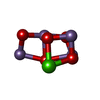 ChemComp-OEX:  ChemComp-FE2:  ChemComp-CL:  ChemComp-CLA:  ChemComp-PHO:  ChemComp-BCR:  ChemComp-SQD: 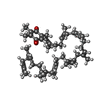 ChemComp-PL9: 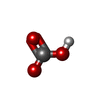 ChemComp-BCT:  ChemComp-LHG: 
ChemComp-F6C:  ChemComp-DGD: 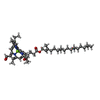 ChemComp-CL7:  ChemComp-LMG:  ChemComp-HEM:  ChemComp-RRX: 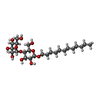 ChemComp-LMT:  ChemComp-HOH: |
| Source |
|
 Keywords Keywords | PHOTOSYNTHESIS / Far-red / photosystem II / cyanobacteria / chlorophyll |
 Movie
Movie Controller
Controller Structure viewers
Structure viewers About Yorodumi Papers
About Yorodumi Papers





 synechococcus sp. pcc 7335 (bacteria)
synechococcus sp. pcc 7335 (bacteria)